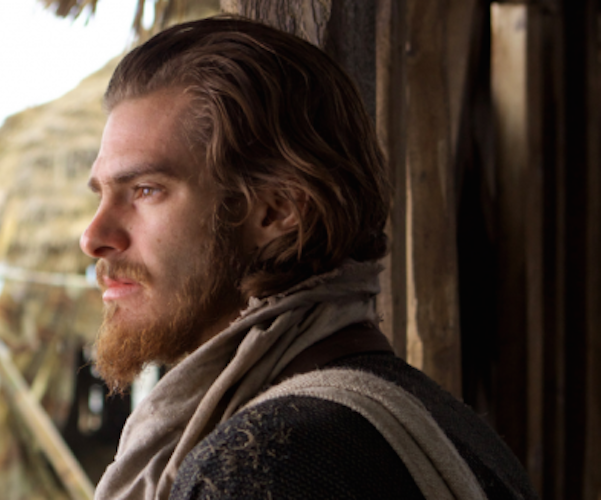Film Review: “Silence” — Martin Scorsese’s Mute Spiritual Odyssey
Did Martin Scorsese want this film about religious faith to reverberate so faintly, to make its point through such awkward stillness?
Silence directed by Martin Scorsese. Screening throughout New England.

Andrew Garfield in a scene from “Silence.”
By Peg Aloi
I try not to find out too much about films before I see them. And prior to the release of Martin Scorsese’s newest film, based on a 1966 novel by Japanese novelist Shūsaku Endō, there wasn’t much to be learned, given the director’s practice of eschewing advance screenings or publicity. I guess if you’re Scorsese you really don’t need the hype or worry much about the critical approval.
Silence is a period piece, or maybe historical is the word: set in the 17th century, it tells the true story of Portuguese Jesuit priests who journey to Japan to offer succor to peasants who have converted from Buddhism to Christianity and who are being jailed, tortured, and executed for heresy. The screenplay is co-written by Scorsese and his frequent collaborator Jay Cocks, who has worked on previous period pieces Gangs of New York and The Age of Innocence.
The film opens with a letter being read in voiceover; it is from the young priests’s mentor Father Ferraira (Liam Neeson) and describes (seen onscreen) Japanese converts suffering while being tortured. The letter describes Ferreaira’s decision to apostasize (renounce his faith) in order to survive. Father Rodrigues (Andrew Garfield) and Father Garrpe (Adam Driver) refuse to believe their teacher has betrayed his beliefs, and they decide, under the urging of their other mentor (Ciaran Hinds), to travel to Japan to find him. First they need a guide, and a Chinese merchant arranges a boat for them with a Japanese guide: a wretched beggar named Kichijiro (Yôsuke Kubozuka, in a noteworthy performance). Upon arrival, Rodrigeus and Garrpe meet with members of a group of secret Christian worshippers; they are told to remain hidden so they won’t be captured. Eventually, they must endure the tyranny of the very inquisitor who has ordered the torture of so many Japanese peasants.
The film is both an historical thriller and an exploration of faith and self-deception. From the first scene on, Rodrigues is the de facto narrator and protagonist, and it is through his experiences that the drama unfolds. Garfield succeeds admirably in portraying a steadfast priest, a deeply moral but straightforward man who sees no reason to waver from his religious path. Garrpe is more conflicted, and wrestles with the trials that the two must undergo. Driver is an unusual actor: his striking looks (huge hands, enormous jet black eyes, and homely face) are in conflict with his laconic manner. Still, he manages to hold his own in what might have been a wrongheaded casting choice (Scorsese’s risky choices in period stories have been questioned before, such as Cameron Diaz in Gangs of New York).
Silence is beautifully photographed and the period details and locations come off as authentic; the visuals are often thrilling. The film also has an unusual sound design: there is virtually no music and no score (despite end credits to the contrary), and many scenes unfold quietly, or in near or total silence. Clearly this metaphor is central, reflecting the silence of the priests who are forced to renounce their faith and never speak of it again. Still, the sounds of nature are heard, which underscores how Christianity took a distinctive form in Japan, an animism in which the “Son of God” is merely re-interpreted as the sun, a solar god.
The impact of this unwavering silence may well make Silence an uncomfortable or unnerving experience for some filmgoers, because its quietude feels so unfamiliar in our sound-saturated environment. That, along with the sometimes disjointed arrangement of elements of the plot and editing, gives the film a strangely hollow feeling. I couldn’t help but wonder if Scorsese meant for a film about religious faith to reverberate so faintly, to make its point through such awkward stillness. For a filmmaker best known for his “noisier” movies, full of bombast, spectacle, flashiness, and extreme examples of human behavior, Silence is a somewhat jarring departure. It stayed with me, like a day of cold and somber weather that affects your mood for weeks, because it has somehow worked its way into your bones.
Peg Aloi is a former film critic for The Boston Phoenix. She has taught film studies for a number of years at Emerson College and is currently teaching media studies at SUNY New Paltz. Her reviews have appeared in Art New England and Cinefantastique Online, and she writes a media blog for Patheos.com called The Witching Hour
